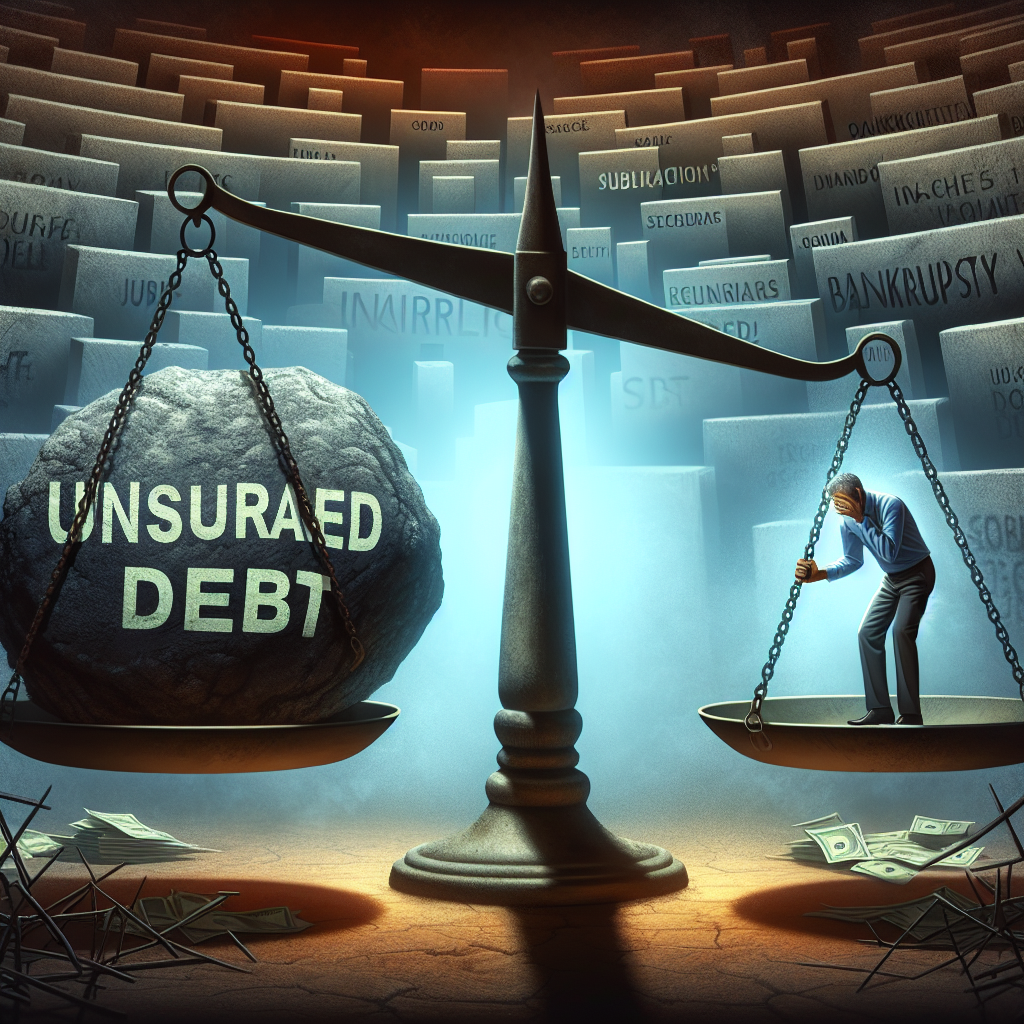
Bankruptcy and unsecured debt
Understanding Bankruptcy and Unsecured Debt
When individuals or businesses find themselves in financial distress, two critical concepts often come into play: bankruptcy and unsecured debt. This article aims to shed light on these concepts, the implications of filing for bankruptcy, and the strategies to manage unsecured debt effectively.
What is Bankruptcy?
Bankruptcy is a legal process that provides individuals or businesses with a fresh start by relieving them of their debts. It allows the debtor to eliminate most or all of their debts, reorganize their financial affairs, or both, depending on the type of bankruptcy filed.
The Types of Bankruptcy
There are several types of bankruptcy, but the most commonly filed are Chapter 7 and Chapter 13 for individuals, and Chapter 11 for businesses. Here's a brief overview:
- Chapter 7 Bankruptcy: Also known as liquidation bankruptcy, this type involves the sale of assets to pay off creditors. Once the process is complete, most unsecured debts are discharged.
- Chapter 13 Bankruptcy: This is a reorganization plan that allows individuals to keep their assets while repaying a portion of their debts over three to five years.
- Chapter 11 Bankruptcy: Mainly used by businesses, this type helps them reorganize their debts while continuing to operate.
Understanding Unsecured Debt
Unsecured debt is a type of debt that is not backed by any collateral. This means that if the borrower fails to repay, creditors cannot claim specific assets to cover the unpaid amount. Common types of unsecured debt include:
- Credit card debt
- Personal loans
- Medical bills
- Student loans (in some cases)
- Some types of business loans
The Link Between Bankruptcy and Unsecured Debt
The relationship between bankruptcy and unsecured debt is vital to understand for anyone facing financial difficulties. While bankruptcy can offer relief, it is essential to recognize its impact on unsecured debts and overall financial health.
The Consequences of Bankruptcy on Unsecured Debt
Filing for bankruptcy can provide immediate relief from unsecured debts, but there are several consequences to consider:
- Credit Impact: Bankruptcy can severely affect your credit score, making it harder to obtain loans or credit in the future.
- Public Record: A bankruptcy filing becomes part of the public record, which may affect your personal and professional reputation.
- Discharge Limitations: Not all debts can be discharged. For example, certain types of student loans or tax debts may still remain after bankruptcy.
Filing for Bankruptcy: The Process
The process of filing for bankruptcy can be complex and varies depending on the type of bankruptcy chosen. Here’s a general outline of what to expect:
- Credit Counseling: Before filing, individuals must undergo credit counseling from an approved agency.
- Filing the Petition: The debtor files a bankruptcy petition with the court, including schedules that outline income, expenses, assets, and debts.
- Meeting of Creditors: A meeting is held where creditors can ask questions about the debtor's financial status.
- Debt Discharge: For Chapter 7, after assets are liquidated and debts settled, eligible debts are discharged. For Chapter 13, a repayment plan is approved by the court.
Alternatives to Bankruptcy
While bankruptcy may seem like a viable solution for managing unsecured debt, it isn't the only option. Here are some alternatives that may help individuals regain control of their finances:
- Debt Settlement: Negotiate with creditors to settle debts for less than what is owed.
- Debt Management Plan: Work with a credit counseling agency to create a plan to pay off debts over time.
- Consolidation Loans: Combine multiple debts into one loan with a lower interest rate for manageable payments.
- Budgeting: Create a strict budget to manage expenses and prioritize debt repayment.
When to Consider Bankruptcy
Deciding to file for bankruptcy is a significant decision that requires careful consideration. Here are some signs that it might be time to consider this option:
- Debt is overwhelming, and repayment seems impossible.
- You are facing wage garnishments or lawsuits from creditors.
- Your credit score is already low due to missed payments or defaults.
Conclusion
Understanding the relationship between bankruptcy and unsecured debt is crucial for anyone grappling with financial challenges. While bankruptcy can provide a fresh start, it comes with long-term consequences that must be weighed against potential benefits. Exploring alternative debt management strategies may also offer a path to financial recovery without the need for bankruptcy. Ultimately, it is wise to seek professional advice when navigating these complex issues to determine the best course of action tailored to individual circumstances.
By Guest, Published on September 18th, 2024